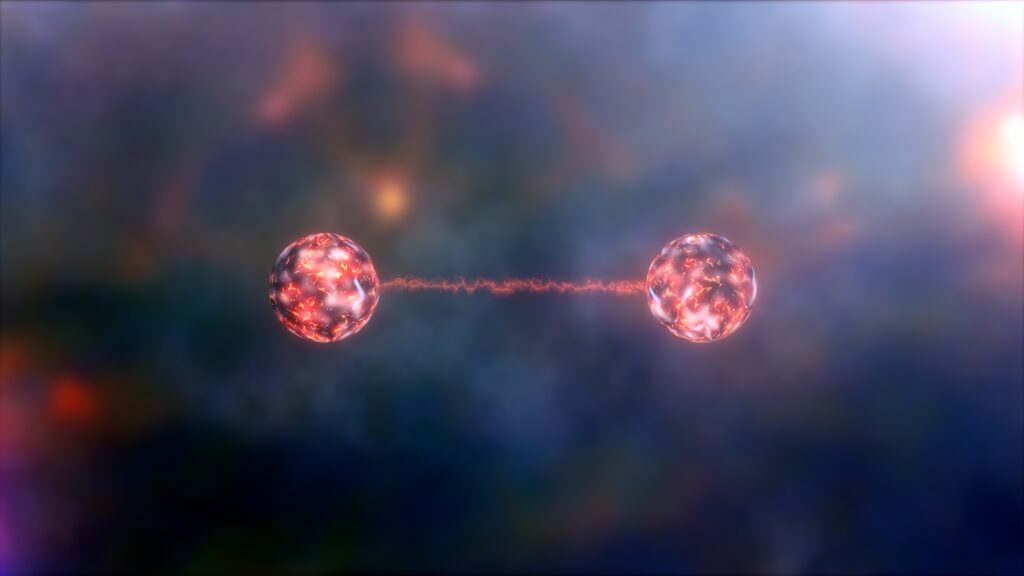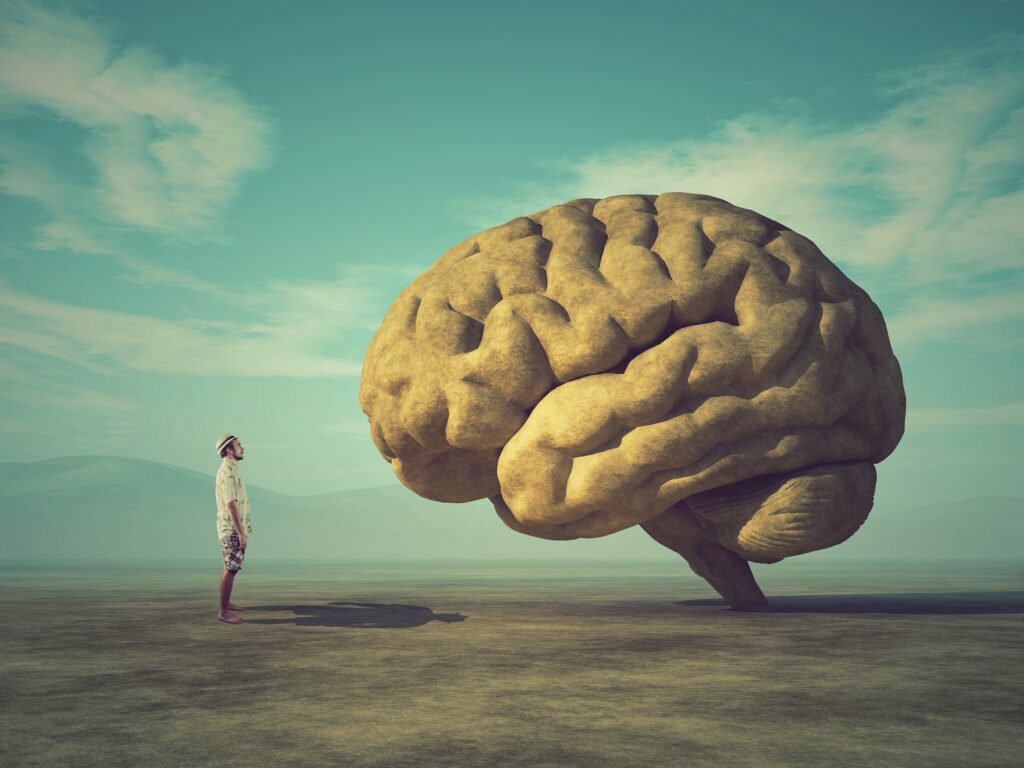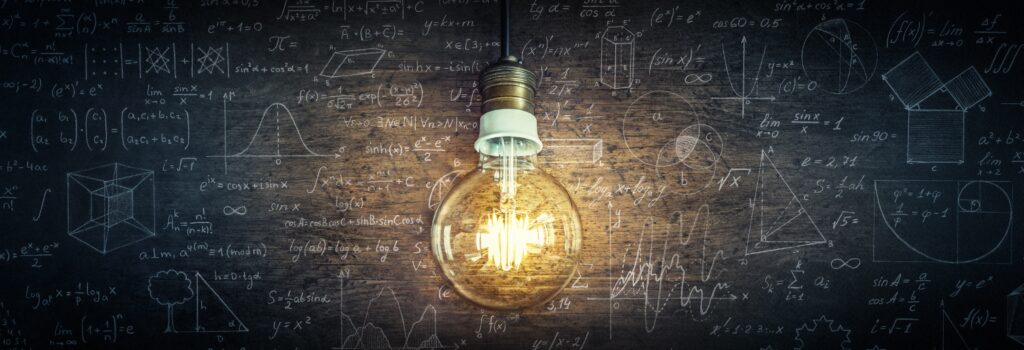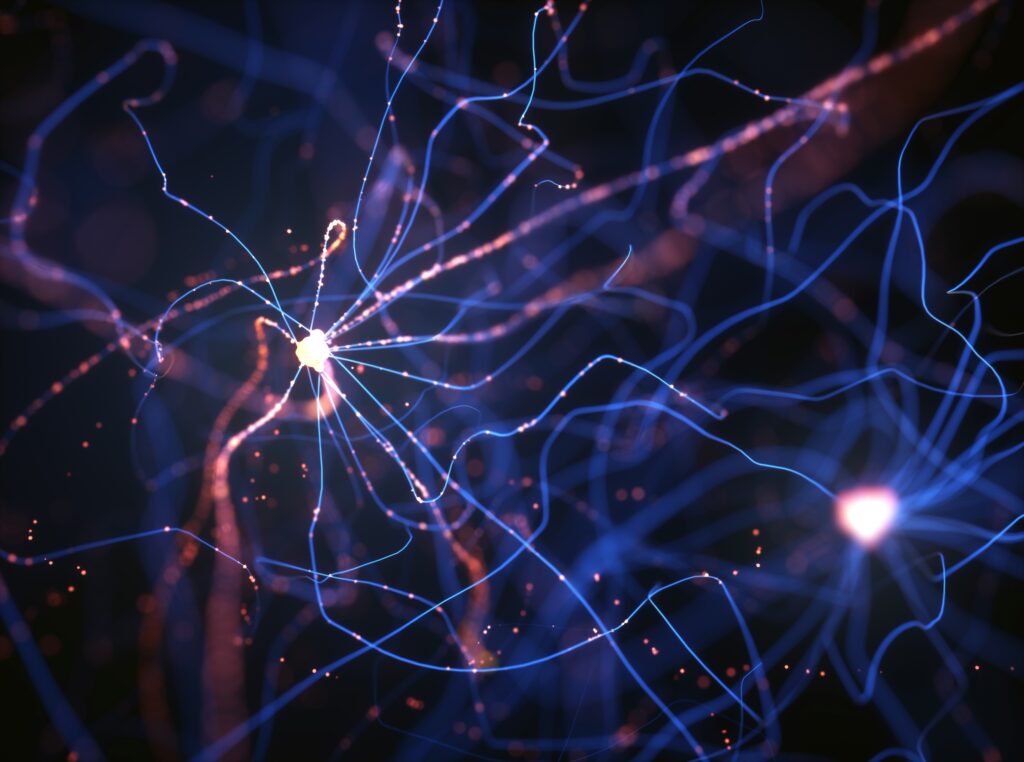How hyper-dimensional spacetime may explain individual identity
Reading | Cosmology
![]() Prof. Bernard Carr, PhD | 2022-06-06
Prof. Bernard Carr, PhD | 2022-06-06
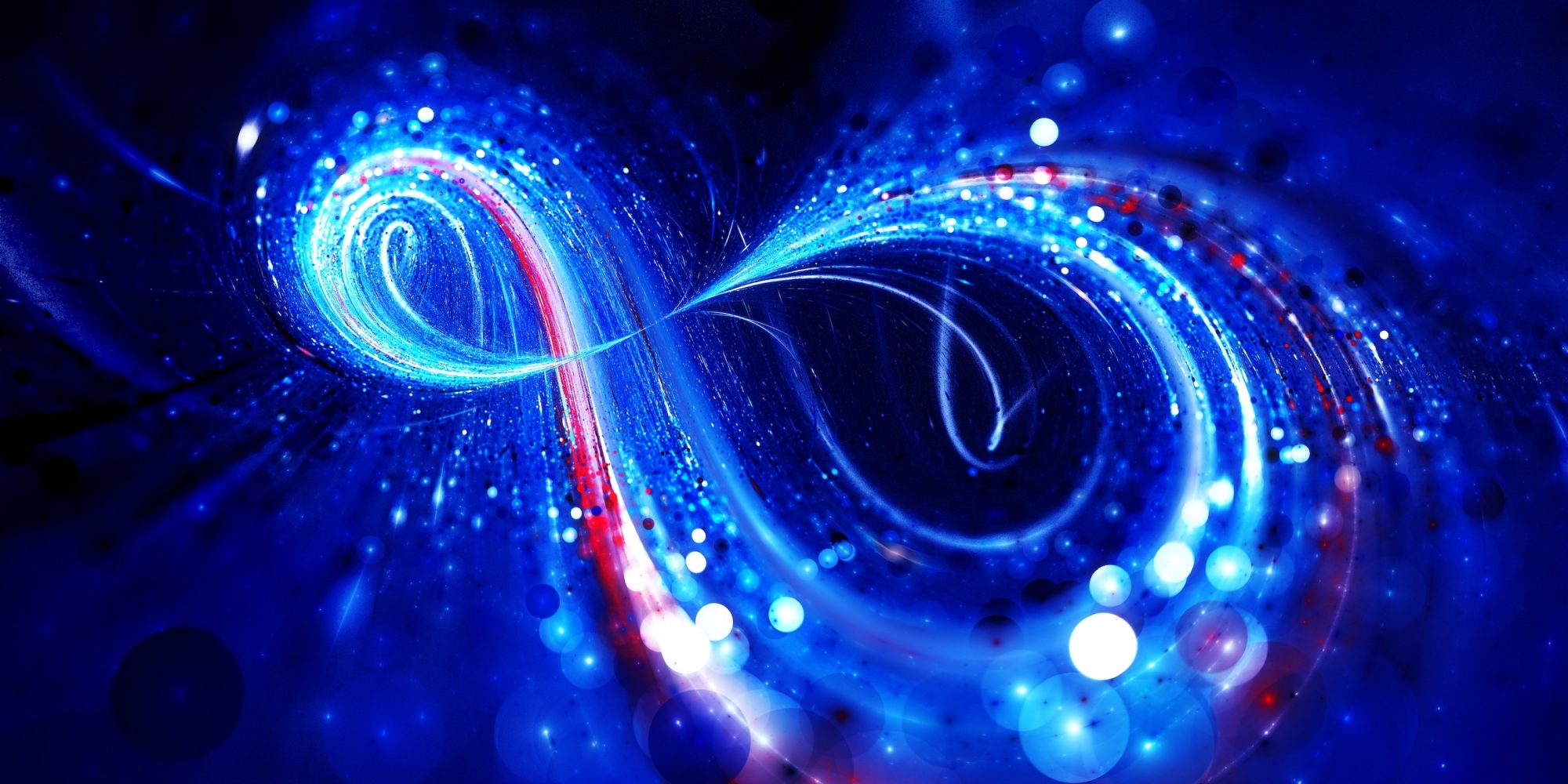
How can one natural consciousness appear to be many? Prof. Bernard Carr proposes that multiple dimensions of time, which can also be associated with the notion of a ‘specious present,’ can resolve the problem both rigorously and in an intuitively satisfying manner. This is a long-form essay that will demand attention and patience from the reader, and perhaps more than one read. But it is also one of the most important essays we’ve ever published, and one that handsomely rewards the effort it requires. It illustrates how fast we can advance to solutions to our basic questions regarding the nature of self and the universe when world-class cosmologists, such as Prof. Carr, approach the problem without metaphysical prejudices.
Bernardo Kastrup’s essay How Can You Be Me? has kindly mentioned my own approach to this question, but without giving many details, so this prompts me to elaborate on the topic. I should explain at the outset that I regard the problem of personal identity (1st personhood) as one the most profound questions not only in philosophy but also in science. Indeed, I will argue that the question Why Am I Me? (slightly different from, but closely related to, Bernardo’s question) is fundamentally unanswerable within the current scientific paradigm. Of course, this question not only confronts myself and Bernardo, it also applies to any conscious being, including any readers of this article.
The problem of 1st personhood is also closely related to the problem of the passage of time, which is also unanswerable within the current paradigm. Indeed, as Bernardo clearly appreciates, the question Why Am I Me? is closely related to the question Why Is It Now? Both questions have been the focus of extensive literature in philosophical circles, but I will argue that there is also a link with physics (my own professional field) and this has received rather scant attention. This is because both problems involve consciousness and this is usually regarded as going beyond the remit of physics, which is traditionally concerned with the 3rd person account of the world. However, the situation has changed in recent years and several respectable physicists have now begun to address this problem. Nevertheless, I should stress that my own proposal does not represent the mainstream view of physicists.
Consciousness and self
Most scientists and philosophers assume that consciousness—and hence the sense of self—is generated by the brain. However, while there are numerous correlations between the contents of consciousness and brain processes, we still have no idea how the brain generates consciousness itself (i.e. 1st personhood). This is the famous “hard” problem of consciousness (Chalmers 1996). Indeed, it is sometimes argued that the brain is merely a filter or receiver of consciousness (Bergson 1946), just as a TV set is a receiver of images produced elsewhere. Clearly this is not the standard view and most of the evidence for the filter model comes from phenomena that have not yet attracted mainstream credence (near-death experiences, terminal lucidity, etc). Nevertheless, it is not easy to refute it or to design experiments to distinguish it from the production model.
The filter model is usually associated with the view that consciousness is a fundamental, rather than incidental, feature of the Universe. It also suggests that mind is a unitary phenomenon, in the sense that “there is one mind common to all individual men … a universal mind” (Emerson 1983). This ‘One Mind’ perspective differentiates between individual consciousness (small c) and the universal Consciousness (big C) that is being filtered. For example, this might arise in an idealistic or panpsychist philosophy, although we need not commit ourselves to either of these views here. Whatever one’s philosophical perspective, the filter model raises the question of how Consciousness can fragment into billions of consciousnesses (even if we confine attention to Earth-based humans) and why I am associated with one particular fragment (i.e. why am I me?). Of course, materialists will reject this question at the outset, since it presupposes that there is some form self that is different from the body. But it’s precisely because the question is meaningless from a materialist perspective that I’m led to reject that materialist perspective.
Bernardo makes the important remark: “The answer to how one universal subject can be many—to how you can be me, as you read these words—resides in a more sophisticated understanding of the nature of time and space.” This is also my own view and in the rest of this essay I will argue that a proper understanding of the passage of time and consciousness requires the invocation of extra dimensions, beyond the 4-dimensional space-time of relativity theory. Indeed, this notion arises within physics itself, as a result of developments in string theory, so it seems natural to connect these ideas.
The passage of time
A long-standing problem on the interface of physics and philosophy concerns the flow of time. The point is that relativity theory does not describe the basic experience of “now” that is such an essential ingredient of our perceptual world. For in the “block” universe of special relativity, past and present and future coexist. So if one regards consciousness as crawling along the worldline of the brain, like a bead on a wire, that motion itself cannot be described by relativity theory (Fig 1a). Thus there is a fundamental distinction between physical time (associated with the “outer” world) and mental time (associated with the “inner” world).
This also relates to the problem of free will. In a mechanistic universe, a physical object (e.g. one’s body) is assumed to have a well-defined future. However, one intuitively imagines that, at any particular time, there are a number of possible futures, with the intervention of consciousness allowing the selection of one of these (Fig 1b). This is one motivation for the growing block universe (GBU), in which the future is not absolutely determined (Ellis 2006). The failure of relativity to describe the process of future becoming past, and different possible futures, may also relate to the collapse of the quantum wave-function to one of a number of possible states, since this also entails a basic irreversibility. Many people have therefore suggested that there could be a link between consciousness and quantum theory.
One way to accommodate the passage of time and the GBU (Broad 1923) is to adopt a second type of time (t2) which relates to mental experience (Fig 1c). At any moment in t2, a physical object might have a unique future in a mechanistic model or a number of possible worldlines in a quantum model. The intervention of consciousness or quantum collapse allows the future to change in the first case or to be selected from in the second case. This does not explain the flow of time itself—since there is passage in both t1 and t2—but it does describe how potential futures can actualise or change. I have also argued (Carr 2021) that this 5D model may relate to brane cosmology, in which physical spacetime is a 4D “brane” moving in a 5D “bulk” (Fig 1d).

Figure 1. The problem of the passage of time (a) and the selection of possible futures (b), and a possible resolution with a 5D model (c), which may connect with brane cosmology (d).
Linking physical space, perceptual space and memory
This model of time also has implications for the relationship between physical space and perceptual space. The traditional view is that the percept is localized within the brain, so that perceptual space is just an internal mapping of physical space with a separate one for each observer. However, this results from the outdated view that the arena of reality is 3-dimensional space. According to relativity theory, the arena of reality is 4-dimensional (4D) spacetime (S4), so perception is a 4D process, with the brain just being one end of the causal chain. So physical perception corresponds to a sort of extended mind (cf. Velmans 2005), in which conscious experience is associated with all the parts of space-time to which the brain is linked through a causal nexus of signalling worldlines (Fig 2a).
Note that the nexus is very concentrated near the tip because it also represents all the neuronal processes involved in perception. The mapping between physical and phenomenal space is therefore complicated and not just a geometrical projection. Also, a more complicated “informational” model would be required to accommodate qualia [Editor’s note: “qualia” are the qualities of experience, such as the redness and sweetness of an apple]. This also has interesting implications for the nature of memory. The mainstream view is that memories are stored in the brain, but if percepts are not inside the head, the same must apply to our memories of those percepts. Indeed, the view encouraged by Figure 2(a) is that memories of physical events reflect the direct access of consciousness to the physical space-time that contains those events. In this case, the brain does not store the memory itself but only some link to the original space-time event, i.e. it contains a tag rather than a trace.
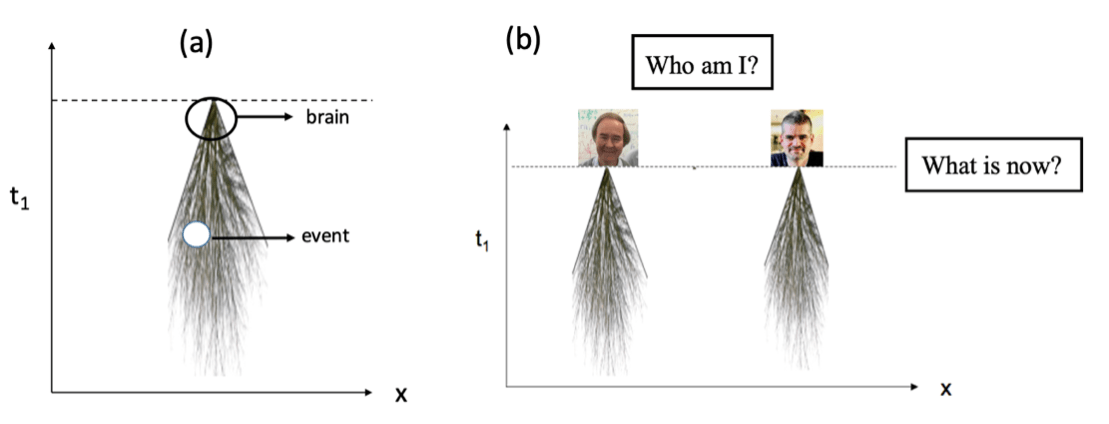
Figure 2. (a) 4D model in which perceptual space is associated with the space-time region connected to the brain via a nexus of signalling world-lines. (b) Illustrating the link between the problem of identity and the problem of the passage of time.
However, if one needs a separate time dimension to describe mental experience, this description of perception and memory cannot suffice. A complete description must involve a 5-dimensional (5D) reality structure S5, with physical space-time (x, t1) and phenomenal space-time (x, t2) being different slices of (x, t1, t2) space (cf. Smythies 1994). The existence of an extra time dimension also has important implications for the nature of personal identity. Clearly Bernard and Bernardo are each associated with a distinct nexus of space-time connections (Fig 2b), but this does not explain why I am associated with Bernard’s nexus. So can a second time dimension elucidate that? More specifically, since physical time t1 and mental time t2 are different, what do we mean when we claim that Bernard and Bernardo are conscious at the same time? They may both be conscious with respect to external time, but 1st personhood presumably relates to internal time. This leads onto a discussion of the next ingredient of our model.
The specious present
Since t2 is invoked to explain mental experience, one might assume that it relates to individual experience. However, we know that the subjective flow of time can vary both for an individual and also from person to person. So how do we describe that? If a change in the rate at which external time appears to pass were interpreted as a change in the gradient dt2/dt1, it would correspond to a spatial variation in the function t2(t1) [Editor’s note: dt2/dt1 represents how fast t2 flows relative to t1 and t2(t1) represents which moment in t2 corresponds to any given moment in t1.]. But this is different from Fig 1(d), which assumes no spatial dependence. Also, what happens under anaesthetic (when no time appears to pass) or during dreams or for an electron (which is presumably unconscious)? These questions are hard to answer in the 5D model, which suggests that the second time dimension relates to a global flow of time rather than the 1st person perspective.
An important point is that the passage of time only makes sense with respect to what is termed the specious present (SP), which might be regarded as the minimum timescale of experience. This concept was introduced long ago (Kelly 1882), but can be understood in modern terms as arising because our physical sensory systems have a resolution time somewhat below 0.1 second, so that we cannot experience a process shorter than this (Herzog et al. 2016). For example, if a light moves in a circle faster than 10 cycles per second, it appears as a static circle, so time in some sense becomes space [Editor’s note: this simple statement is a key point, so briefly reconsider the metaphor until you grasp it]. There is also an upper limit to the timescale of experience, since our brains are not aware of changes that are too slow. This is not determined so precisely but it is certainly less than a human lifetime and it may be around 103 seconds if associated with short-term memory.
Although the SP is well-determined during the usual waking state and roughly the same for everyone, it may change in some circumstances, in the sense that the passage of internal (mental) time may change relative to that of external (physical) time. For example, this may happen in an accident (SP decreases) or a fever (SP increases) or as a result of taking certain drugs. Presumably, such variations can be explained by the brain having some internal clock whose rate can change (Eagleman et al. 2005). However, some changes in the SP are more dramatic (Wittmann 2018). For example, in a Near Death Experience (NDE) one may see one’s whole life ‘instantaneously,’ and in certain mystical states the SP may seem to shrink almost to zero or expand almost to infinity (Taimni 1961). It is not clear that such experiences can be explained neurologically, so this may support the suggestion that the brain is a filter rather than a generator of consciousness.
Since we only experience consciousness over a narrow range of timescales and there can be no experiences to remember on a timescale less than the SP, this raises the question of whether there could be other forms of consciousness in the universe—not necessarily associated with brains and perceiving the world through organs sensitive to a different frequency range—with a very different SP. This would be analogous to how we perceive electromagnetic radiation over the narrow range of frequencies associated with visible light. It is not necessarily a mystical notion, since the physical world contains complex structure over a wide range of scales.
The problem of identity
The notion of the SP is also relevant to the problem of personal identity. The traditional view is that my consciousness is localized in so much as the sensors through which I perceive the world are localized, so I am me because I have a unique history that differentiates my perspective from everyone else’s. More precisely, my identity is defined by the nexus of spacetime connections (Fig 2a). Clearly, the bodies of myself and Bernardo are in different places, so this is why I’m different from Bernardo (Fig 2b).
However, this does not solve the problem of identity because it does not explain why I am identified with a particular nexus. To illustrate this, imagine that myself and Bernardo (i.e. our bodies) were born at exactly the same time in neighbouring beds in the same maternity ward. Our neurons start to fire and we become conscious simultaneously. So why does my self become associated with Bernard’s body rather than Bernardo’s? If consciousness is produced by the brain, this question is meaningless because there can be no me distinct from the body. But that is precisely why we are obliged to adopt the filter model, and the following discussion will be within that context.
One possible (religious?) answer to the question is that my consciousness is associated with some form of mental body (soul?), which pre-existed my physical body, is temporarily anchored to it during life, and will separate from it at death. Indeed, even within life there may be phenomena (e.g. Out of Body Experiences, or OBEs) that suggest the existence of such a mental body. This explanation may be unpalatable to materialists but it is at least compatible with the filter model. However, even if one accepts this view, one must still ask why I am associated with a particular mental body, so this merely raises the problem at a higher level.
A second possibility within the filter proposal is that my individual identity will be lost at death, with my consciousness becoming part of some greater collective Consciousness. Or perhaps the first state just represents an intermediate state before the second. Whatever one’s view, there is clearly a link between the nature of identity and the issue of whether consciousness exists before birth and after death. There is a huge literature on this topic—from philosophers and theologians of all persuasions—but all I wish to stress here is that both views face the problem of how Consciousness can fragment.
Space, time and higher dimensions
As indicated in Figure (2b), there is evidently a connection between the problem of now, related to a special point in time, and the problem of me, related to a special point in space. This is because the distinction between space and time is fuzzy in relativity theory. I will now elaborate on this point by addressing two different but related puzzles and arguing that these require the existence of extra dimensions going beyond space and time.
The first puzzle concerns why the younger and older Bernardo are both linked with the same self. The obvious answer is that his identity is associated with his 4D body (i.e. his worldline) rather than his 3D body (cf. Fig 2a). But he also has an identity on the scale of the 3D specious present, SP1, which is merely a segment of his 4D body (cf. an Alzheimer patient who has little memory of his previous self). Indeed, all the SP1s on his worldline connect like links in a chain to form his higher 4D self. Although the SP1s don’t interact directly, because they are at different values of t1, Bernardo is aware of this 4D self and the flow of time is what links them. Indeed, since there is no distinction between past and future within the SP1, we can envisage it as a closed loop in time which rolls along his worldline (Fig 3a).
At this point, I would like to introduce another crucial (albeit contentious) step in my argument. In certain states Bernardo’s SP may increase so that he experiences his whole life as a single moment. For example, the life review component of an NDE has this feature and this suggests that there is a ‘higher’ level of consciousness—still individualized but with a specious present SP2 exceeding the human lifetime. (This might be compared to the light in the earlier example going around faster than 10 rotations per second.) Since the longer SP can also be represented by a closed loop, the usual flow of time experienced by Bernardo corresponds to the small circle moving within a larger circle (Fig 3b). This also suggests the existence of any extra dimension with respect to which the timeline is curved.
The second puzzle concerns the relationship between Bernard and Bernardo. How can they be the same and yet different? Bernardo’s answer—inspired by his father’s chess game with himself and his own experience under anaesthetic—is that one can patch together successive experiences from a multitude of perspectives into parallel (seemingly continuous) experiences, each from a single perspective. This reminds me of how, during my first visit to the USA, I was overwhelmed by the number of movies on TV because there were so many channels. However, I found that I could watch several of them at the same time without losing the plots by switching channels at some appropriate frequency (cf. the film The Man Who Fell to Earth, in which David Bowie watches dozens of TV screens simultaneously).
A key ingredient to experiencing a single perspective in this picture is experiencing none of the others and this is why Bernardo’s anaesthetic experience is relevant. His proposal does not solve the problem of identity completely, because he’s not explained why he’s associated with a particular perspective, but it’s interesting because it relates the problem of spatial separation to one of temporal separation. In this context, we note that there is a link between temporal resolution and spatial resolution. For not only does Bernardo cease to experience the passage of time (i.e. to have a self) on too large or too small a time scale, his body also ceases to have an identity on too large or too small a length scale: it is too small to be resolved on a planetary scale and too large for its integrity to be recognized on an atomic scale.
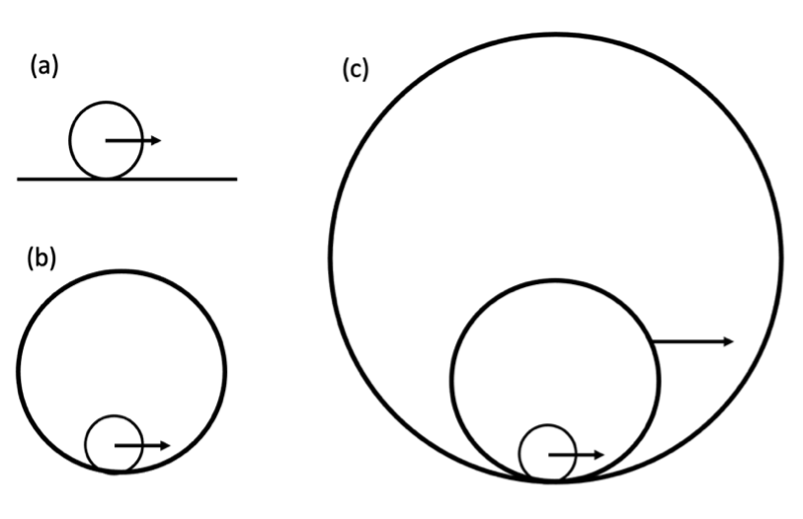
Figure 3. Illustrating how a hierarchy of specious presents and the passage of time may be represented by a sequence of compact dimensions in relative motion. (a) corresponds to SP1, (b) to SP2, (c) to SP3, etc.
At this point, I should draw attention to another anomalous state in which the identities of different people appear to merge. For example, in the life review of an NDE one may re-experience an interaction from the perspective of someone else. Or one may have a mystical experience in which one feels identified with the whole of humanity (cosmic consciousness?). I would argue that this suggests that there is a 5D level of consciousness with a specious present SP3 much exceeding SP2. In this case, the bigger circle in Figure 3(b) moves around the still bigger circle in Figure 3(c). From this higher perspective, all the SP2s are links in a chain of global identity, with the 5D self linking 4D selves across space just as the 4D self links 3D selves across time. Since SP3 is much larger than SP2, the 5D self does not experience the flow of time of Bernard and Bernardo and therefore cannot discriminate between them.
Although the raising of 4D consciousness to the 5D level is analogous to the raising of 3D consciousness to the 4D level, there is an important difference between these two cases. The SP1s are explicitly linked by a 4D worldline but there is no 4D link for the SP2s. However, lines which are disconnected in 4D space may be connected in a 5D one. So while Bernardo and Bernard have distinct identities in (x, t1) space, they may be connected in the (x, t1, t2) space.
This model is reminiscent of the old idea that all electrons and positrons are identical because there is a single electron zig-zagging forwards and backwards in time (Wheeler 1940), with positrons corresponding to the backwards portions (Fig 4a). Obviously, Bernardo is different from an electron, since he experiences a passage of time and is not going backwards in time. However, one can envisage a similar diagram by adding an extra dimension t3, as indicated in Figs 4b and 4c; this is not identified with t2, since this only corresponds to a global passage of time. More explicitly, we introduce a separate (x, t1) plane for each observer and colour these red and blue. Both worldlines appear in each (x, t1) plane but only one (shown bold) is associated with consciousness and the bold lines define a single path in the (x, t1, t3) space. Personal identity is therefore associated with a particular plane.
There could be various 5D zig-zag paths connecting the two worldlines. One (clearly exotic) possibility is a path which connects the end of Bernard’s worldline to the start of Bernardo’s (Fig 4b). This would be analogous to a time machine in which I go back in time (i.e. in t1), so that I coexist with my first self but maintain a separate consciousness (i.e. in t3). There would then be two consciousnesses during our overlapping lifetimes from the 4D perspective, but only one from the 5D perspective. For an SP exceeding the spacing (i.e. SP3), both Bernard and Bernardo are conscious. But for the SP of Bernard and Bernardo themselves (i.e. SP1), they are sequential. One might also envisage a 5D path which then connects the end of Bernardo’s worldline to the start of Bernard’s, as indicated by the link to the green plane in Fig 4b. However, one avoids the ambiguity of which plane comes first in t3 if the extra dimension is closed on the scale of SP3, so that one can identify the top (green) plane with the bottom (red) plane.

Figure 4. Zig-zag model: (a) for electrons in (x, t1) space; (b) for Bernard (red) and Bernardo (blue) in (x, t1, t3) space with retro-causal connections; and (c) for Bernard and Bernardo in (x, t1, t3) space with causal connections. If the extra dimension is compactified, the top (green) and bottom (red) planes are identified.
Of course, this model is very simplistic, since there are billions of consciousnesses and not just myself and Bernardo. But if one can have one loop in t1, one can presumably have many, so the model is easily extended. This is reminiscent of Nietzsche’s “eternal recurrence,” except that one does not return as oneself but as someone else. Another complication is that a 5D path might link to a bold line in the t1 future (cf. reincarnation), rather than the t1 past, in which case bold lines might even merge or fragment. All these possibilities can be represented by various kinds of connection in the 5D space, but this issue will not be pursued further here.
Another possibility, closer to Bernardo’s ‘chess-playing’ proposal, is that the zig-zag in the extra dimension occurs throughout the lives of Bernard and Bernardo (Fig 4c), but on a time scale less than SP1, so that each of us experience continuity of consciousness. This model is less exotic than the first, since it does not involve going backwards in t1, but many other features are the same. In particular, Bernard and Bernardo are simultaneously conscious from a 4D perspective, but sequentially conscious from a 5D perspective. And if the extra dimension is closed on the scale SP3, one can again identify the red and green planes.
Conclusion
I have argued that mind can be accommodated in physics by introducing a 5D psychophysical space which merges the phenomenal space of ordinary perception with physical space, the 5th dimension being associated with mental time. While one has a distinct identity in the lower dimensional (x, t1) space, associated with a 4D nexus of signalling worldlines, one is connected with other consciousnesses in the higher dimensional (x, t1, t2) space. The multi-level time perspective therefore helps to explain how there can be many manifestations of a unitary consciousness. However, I have argued that the fragmentation of this into a myriad of individual consciousnesses also requires the notion of a specious present and this may require further dimensions. Clearly, this proposal is very unconventional from both a physical and philosophical perspective, but I note that Schooler (2015) has advocated a similar approach.
Although it goes beyond the present discussion, I have argued elsewhere (Carr 2015) that various transpersonal experiences suggest the existence of a space with more than five dimensions—termed the Universal Structure—which contains mental experiences of all kinds. I then identify this Universal Structure with a higher-dimensional model of modern physics, in which the physical Universe is regarded as a 4D slice of a higher-dimensional space. For if physical objects occupy only a limited part of the higher-dimensional space, it is natural to ask whether anything else exists there and the only non-physical entities we experience are mental ones.
But what is the nature of the extra dimensions? In standard M-theory they are spatial and compactified on the Planck scale (10-33cm). However, in principle the compactification scale could be much larger and we have seen that one dimension is extended in brane cosmology. One could also consider a model in which the extra dimensions are compactified on a hierarchy of scales (cf. Fig 3c) and I have suggested that each dimension could be associated with a specious present. One would then have a hierarchy of levels of consciousness associated with a hierarchy of time dimensions. This need not imply commitment to M-theory itself, but one does require some form of higher-dimensional model. This proposal is clearly very speculative and certainly does not represent mainstream physics. Indeed, most physicists would not accept the reality of the phenomena which I’m trying to explain. Nevertheless, this illustrates how physics might at least in principle be extended to accommodate mind.
References
Bergson, H. (1946). The Creative Mind (trans M.L. Andison). New York: Philosophical Library.
Broad, C.D. (1923). Scientific Thought. London: Routledge & Kegan Paul.
Carr, B.J. (2015). Hyperspatial models of matter and mind. In E.F. Kelly, A. Crabtree and P. Marshall (eds) Beyond Physicalism: Toward Reconciliation of Science and Spirituality, pp. 227-73. Maryland: Rowman & Littlefield.
Carr B.J. (2021). Making space and time for consciousness in physics. In P. Dennison (ed) Perspectives on Consciousness, ed., pp. 319-350, Nova Science Publishers.
Chalmers, D.J. (1996). The Conscious Mind: In Search of a Fundamental Theory. New York: Oxford University Press.
Eagleman, D.M., Tse, P.U., Buonomano, D., Janssen, P. et al. (2005). Time and the brain: how subjective time relates to neural time. Journal of Neuroscience, 25: 10369-71.
Ellis, G.F.R. (2006). Physics in the real universe: time and spacetime. General Relativity and Gravitation, 38(12): 1797-1824.
Emerson, R.W. (1983). Essays and Lectures. Library of America.
Herzog, M.H., Kammer, T. and Schamowski, F. (2016). Time slices: what is the duration of a percept? PLoS Biol., 14(4): e1002433.
Kelly, E.R. (1882). The Alternative: A Study in Psychology. London: Macmillan.
Randall, L. and Sundrum, R. (1999). An alternative to compactification. Physical Review Letters, 83: 4690-93.
Schooler J. (2015). Bridging the object/subjective divide. In T. Metzinger and J.M. Windt (eds.) Open MIND: 34.
Smythies, J.R. (1994). The Walls of Plato’s Cave: The Science and Philosophy of (Brain, Consciousness and Perception). Aldershot, England: Avebury.
Taimni, I.K. (1961). The Science of Yoga. Wheaton, IL: Theosophical Publishing House.
Velmans, M. (2005). Are we out of our minds? Journal of Consciousness Studies, 12: 109-16.
Wheeler J. (1940). Exchange reported in R. Feynman’s 1965 Nobel lecture.
Wittmann, M. (2018). Altered States of Consciousness: Experiences out of Time and Self. MIT Press.

Essentia Foundation communicates, in an accessible but rigorous manner, the latest results in science and philosophy that point to the mental nature of reality. We are committed to strict, academic-level curation of the material we publish.
Recently published
Reading
Essays
Seeing
Videos
Let us build the future of our culture together
Essentia Foundation is a registered non-profit committed to making its content as accessible as possible. Therefore, we depend on contributions from people like you to continue to do our work. There are many ways to contribute.






